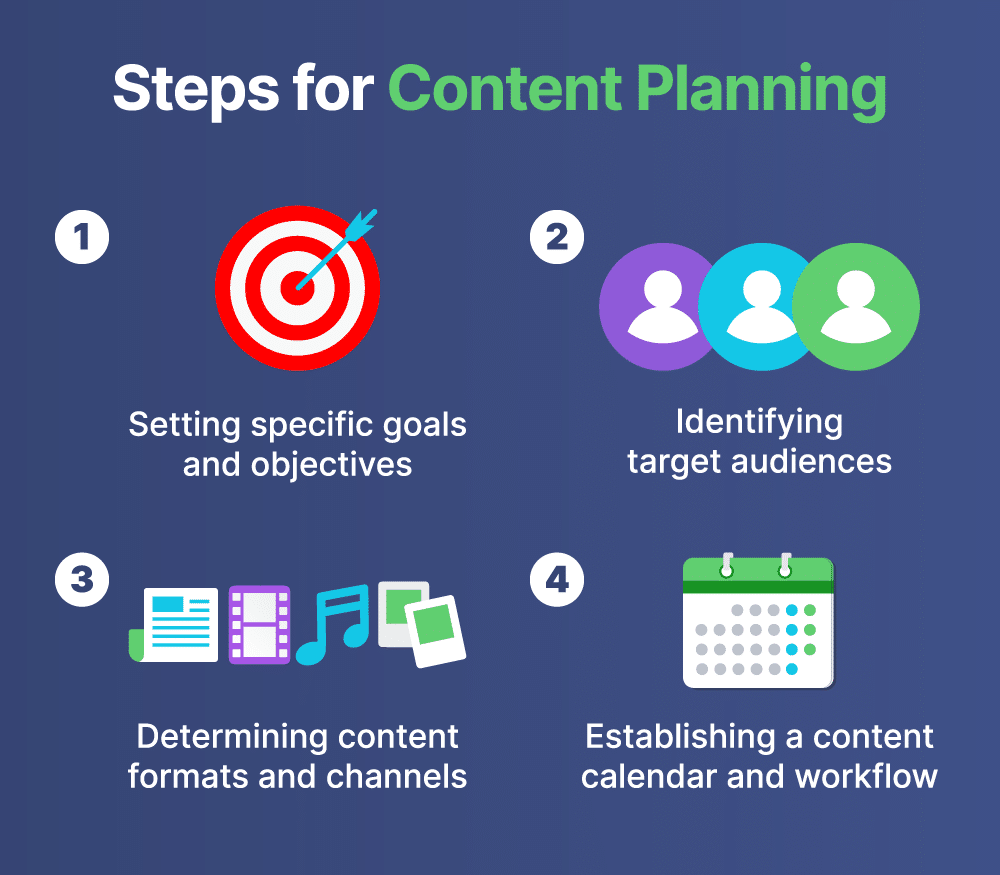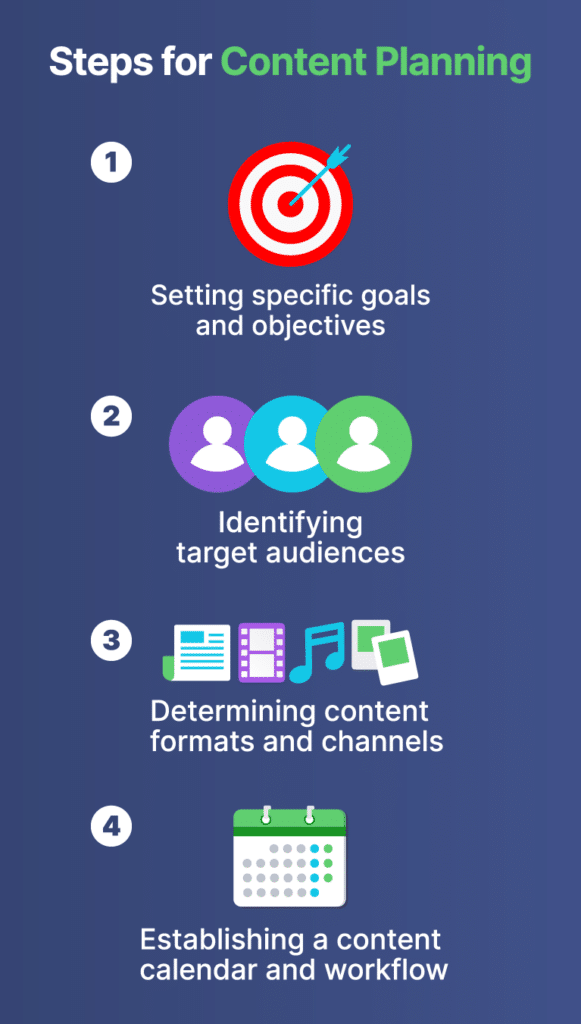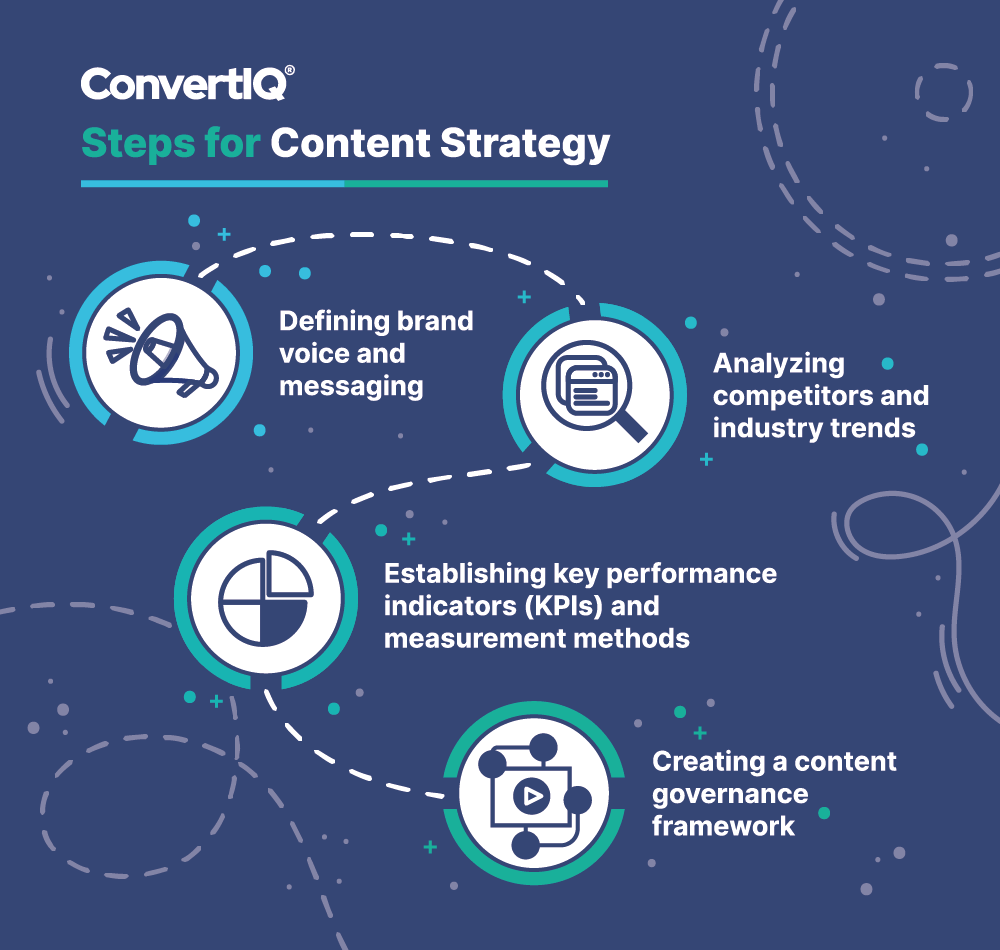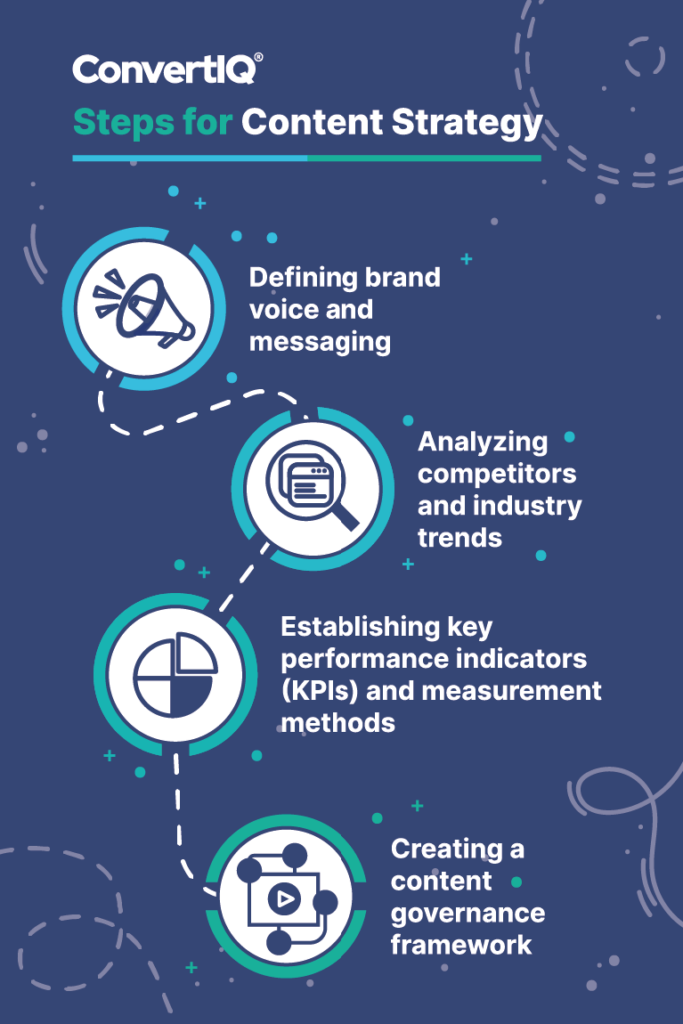In the world of content marketing, it’s essential to understand the key differences between content planning and content strategy. Both elements play a crucial role in driving successful campaigns, but they serve distinct purposes. This blog post will delve into the unique aspects of content planning and content strategy, highlighting their importance in creating high-quality, targeted content that resonates with your audience. By gaining a clear grasp of these concepts, you’ll be better equipped to develop effective content marketing campaigns that align with your business objectives and set your brand apart from the competition. So, let’s dive in and explore the world of content planning and strategy!
Defining Content Planning and Content Strategy
Content planning and content strategy are two key concepts in the world of content marketing. Both are necessary for creating successful campaigns, but they serve distinct purposes.
Content Planning
Content planning is the process of organizing, scheduling, and managing the creation and distribution of various types of content. It encompasses the tactical aspects of content creation and distribution, with a focus on immediate results. Content planning involves:
- Setting specific goals and objectives
- Identifying target audiences
- Determining content formats and channels
- Establishing a content calendar and workflow


Content Strategy
Content strategy, on the other hand, is the overarching framework that guides the development, execution, and management of content. It extends beyond immediate production and distribution considerations; encompassing the big-picture view of content while incorporating ongoing optimization, analysis, and revision. Strategic content focuses on long-term objectives that span both organizational goals such as top-line growth or profitability as well as customer needs including acquisition. A content strategy involves:
- Defining brand voice and messaging
- Analyzing competitors and industry trends
- Establishing key performance indicators (KPIs) and measurement methods
- Creating a content governance framework


Content Planning & Strategy In Action
Let’s take a hypothetical example of a content manager at a jewelry store to illustrate the implementation of content planning and content strategy.
The content manager conducts market research and identifies that rose gold engagement rings and permanent jewelry are currently trending in the industry. They meet with the C-suite and branding team to define content guidelines tailored to the store’s competitive advantage, which includes elite customer service, personalization, and industry expertise. They determine that the store won’t compete on price and should never promote cheap or affordable jewelry.
Based on the content strategy, the content manager now proceeds with planning specific actions:
1. The content manager identifies three blog topics that will resonate with the target audience interested in permanent jewelry. Topics include “Timeless Designs: Exploring the Beauty of Permanent Jewelry,” “Choosing the Perfect Precious Metals: A Guide to Lasting Elegance,” and “Caring for Your Precious Gems: Expert Tips for Jewelry Preservation.”
2. The content manager schedules four social media posts featuring rose gold engagement rings. These posts are carefully crafted to highlight the store’s expertise, personalized customer experiences, and the unique qualities of rose gold jewelry. Captions may include messages such as “Discover the allure of rose gold engagement rings – a symbol of timeless love and sophistication. At our store, each piece is meticulously handcrafted to reflect your individual style. Experience the luxury of personalization with our expert jewelers.”
By aligning the content planning with the content strategy, the content manager ensures that the published content reinforces the store’s key differentiators, promotes trending products, and appeals to the target audience interested in permanent jewelry. This strategic approach helps establish the store as a trusted authority, build brand loyalty, and drive both in-store and e-commerce sales, generating sustainable business growth.
The Importance of Content Planning
Content planning is an essential part of content marketing, as it provides the framework for creating and distributing content. A well-structured content plan helps businesses maintain a regular publishing schedule, which can improve audience engagement and retention. It also ensures that content creators stick to the planned topics and formats, avoiding haphazardly created pieces that can be detrimental to your brand’s image. Without a structured plan in place, businesses may run into problems such as missed deadlines or failed promotions.
Content planning also helps create content that resonates with the target audience. By understanding the goals of the organization and the preferences of the target audience, content creators can tailor their content to resonate with readers and drive desired outcomes. Moreover, content planning facilitates efficient content creation and distribution by identifying the most appropriate formats and channels to reach the target audience. Moreover, by setting KPIs to evaluate content performance and track progress toward goals, companies can adjust their content plans in real-time to maximize results.
The Importance of Content Strategy
Content strategy is a high-level framework that helps businesses develop effective content marketing campaigns. By establishing the why, what, and how behind your content creation efforts, this frame of reference provides a focus to ensure consistency in brand messaging across all platforms. It acts as a guiding force for content planning and execution, making certain that every piece of content created serves a specific purpose in supporting the business’s objectives.
Content strategy also involves analyzing competitors and industry trends, allowing businesses to stay ahead of the curve and create content that resonates with their target audience. By establishing key performance indicators (KPIs) and measurement methods, businesses can track the success of their content and make informed decisions for future content creation. Additionally, a content governance framework helps maintain consistency in brand voice and messaging across all content, ensuring a cohesive and professional brand image.
Key Components of an Effective Content Plan
To develop an effective content plan, several key components need to be considered.
Setting Clear Content Goals and Objectives
First and foremost, setting clear content goals and objectives is crucial, as this helps you stay focused on the desired outcomes and align your content with your broader business objectives. Your goals should be specific, measurable, attainable, relevant, and time-bound (SMART).
Understanding Your Target Audience
Thoroughly understanding your target audience is also essential for creating successful content. Building detailed customer personas helps you gain insight into the wants and needs of your readers. This includes researching demographics, preferences, pain points, and content consumption habits to effectively tailor your content to their expectations.
Determining the Most Suitable Content Formats and Channels
Determining the most suitable content formats and channels is another key aspect of an effective content plan. This may involve considering the types of content that best suit your audience’s preferences and the platforms where they are most active, such as blog articles, social media posts, videos, podcasts, or webinars.
Establishing a Content Calendar and Workflow
Establishing a content calendar and workflow helps keep your content production on track and ensures a consistent publishing schedule. This involves assigning deadlines, responsibilities, and resources for each piece of content, as well as outlining the steps required for ideation, creation, editing, and distribution. Finally, establishing metrics for content measurement allows you to track the success of your efforts and optimize future strategies.
Key Components of an Effective Content Strategy
Content strategy is the overarching framework that guides the development, execution, and management of content. To ensure success, an effective content strategy should include the following components:
Defining Brand Voice and Messaging
Establish a consistent voice and messaging that resonates with your target audience and reflects your brand identity. This consistency helps build trust and credibility with your audience, making them more likely to engage with your content and convert into customers.
Analyzing Competitors and Industry Trends
Conduct regular competitor analysis and stay informed about industry trends to identify content opportunities and potential gaps in your current content offerings. This knowledge allows you to create content that outperforms your competition and addresses the evolving needs of your audience.
Establishing KPIs and Measurement Methods
Determine what success looks like for your content marketing efforts by setting clear KPIs, such as website traffic, social media engagement, or lead generation. Establish a system for tracking and measuring these KPIs to evaluate the effectiveness of your content and optimize future strategies.
Creating a Content Governance Framework
Develop guidelines and processes for managing content creation, distribution, and maintenance. Establishing this structure helps maintain control over the quality of content being produced and ensures it aligns with your brand standards. It also enables you to use best practices for policies such as copy editing, plagiarism prevention, and social media utilization guidelines.
How Content Planning and Strategy Work Together
Content planning and content strategy are two distinct yet interrelated concepts. While content planning focuses on the tactical aspects, such as content formats, channels, and scheduling, content strategy provides a broader, long-term vision for content development, ensuring alignment with overall brand messaging and goals.
The interplay between planning and strategy in content marketing is crucial for creating a cohesive, well-rounded approach to content creation and distribution. By integrating both elements effectively, brands can ensure their content resonates with their target audience and drives the desired results. When developing content plans and strategies, it’s best to start with an overarching content strategy. Begin by defining the purpose of your messaging and creating a long-term vision for its execution. This strategy then informs the content planning process, where content creators develop specific ideas, formats, and distribution channels that align with the strategic vision.
In this synergistic relationship, content planning and strategy work together to inform, guide, and optimize each other, ultimately creating a more effective and impactful content marketing campaign. By understanding the unique roles of each element and leveraging their strengths in tandem, businesses can maximize their content marketing efforts, resulting in increased visibility, engagement, and overall brand success.
Tips for Creating a Comprehensive Content Creation Plan
- Develop a deep understanding of your target audience: To create a comprehensive content creation plan, begin by developing a deep understanding of your target audience. This includes their demographics, preferences, pain points, and the type of content they find most valuable. Use this information to tailor your content to their specific needs and interests.
- Develop a content calendar: Developing a content calendar is essential for maintaining a consistent posting schedule. A content calendar helps you plan content topics, formats, and distribution channels, ensuring a steady flow of high-quality content. It also allows you to track important dates, holidays, and industry events, enabling you to create relevant and timely content.
- Collaborate among team members and stakeholders: Collaboration among team members and stakeholders is a key aspect of successful content planning. Encourage brainstorming sessions, idea sharing, and constructive feedback to generate a diverse range of content ideas. This collaborative approach also ensures that content aligns with overall business objectives and supports various departments within your organization.
- Measure and analyze content performance: Continuous measurement and analysis of content performance are vital to optimizing your content creation plan. Set up analytics for measuring website traffic, social media engagement, lead generation and other KPIs to gain a clear understanding of how your content is performing. Use these insights to make data-driven decisions, adjust your content plan to better serve your audience and achieve your goals.
Tips for Developing a Robust Content Strategy
- Conduct a content audit: Assess your current content assets to identify strengths, weaknesses, and gaps in your content offerings. Use this information to determine gaps in the content landscape and create a strategy for filling them. This helps ensure that your content efforts are organized, targeted, and comprehensive.
- Be flexible and adjust content plans as needed: Maintain flexibility within your strategy to ensure that you can pivot quickly when necessary. This will enable you to stay agile and responsive to changing market conditions, audience preferences, and industry trends.
- Leverage data and insights to inform content decisions: Use analytics and data-driven insights to guide your content strategy, ensuring that your content decisions are informed by a solid understanding of your audience’s needs, preferences, and behaviors.
- Continuously monitor and measure: Review your content performance regularly using the KPIs you’ve established. Collected data provides invaluable insights into how to adjust your strategy where necessary, allowing for ongoing optimization. This will enable you to continually innovate and adapt your content strategy to stay ahead of the curve.
Tools and Resources for Content Planning and Strategy
Leveraging advanced tools and resources can help take the stress out of content planning and strategy development. These can help streamline the process, save time, and ensure that your content is aligned with your overall objectives.
Content Planning Tools
Content planning tools and platforms are invaluable for organizing and scheduling content. Some popular options include Trello, Asana, and CoSchedule. These tools help create and manage content calendars, assign tasks to team members, and track the progress of content creation and distribution.
Content Strategy Tools
For content strategy development, frameworks and templates can provide a useful starting point. Some well-known frameworks include the Content Strategy Canvas, HubSpot’s Content Strategy Template, and the Content Marketing Institute’s Content Marketing Framework. These resources guide key components of a content strategy, such as defining a target audience, setting objectives, and establishing KPIs.
ConvertIQ
ConvertIQ is an exceptional content planning and strategy tool that provides invaluable assistance to content managers and marketers. Leveraging real-time data and analytics, ConvertIQ aids in content strategy by identifying emerging trends, analyzing search volume, and uncovering relevant insights. By utilizing this tool, content managers can make informed decisions about the direction of their content, ensuring it aligns with the interests and needs of their target audience.
Moreover, ConvertIQ proves highly effective in content planning by offering a multitude of stack-ranked blog topics that can be generated instantly with just a click of a button. This feature saves time and effort in brainstorming content ideas manually, allowing content managers to access a ready-made list of topics tailored to their niche and audience. Additionally, ConvertIQ also boasts editing features that enable users to refine and fine-tune their content, ensuring its quality and relevance.
With the aid of ConvertIQ, content managers can streamline their content planning and strategy efforts, capitalize on trending topics, and deliver engaging and tailored content that resonates with their audience.
Staying Informed About Industry Trends and Best Practices
Staying informed about industry trends and best practices is crucial for successful content marketing. Some resources that offer valuable insights include Content Marketing Institute, MarketingProfs, and Copyblogger. These websites provide articles, case studies, and research reports on content marketing and content strategy, helping you stay up-to-date on the latest developments and techniques.
Additionally, don’t overlook the importance of learning from successful content campaigns within your industry. Analyzing the strategies and tactics used by your competitors can provide valuable insights and inspiration for your own content planning and strategy efforts.
Brand-Specific Content Planning and Strategy Considerations
Each brand has its own voice, values, and messaging, which should be consistently reflected in the content produced. To achieve this, ensure that your content strategy incorporates your brand’s key characteristics, tone, and personality.
Adapting content planning and strategy to your specific industry and audience is equally important. Different industries have varying trends, customer expectations, and content consumption habits. For instance, a tech company might focus on creating in-depth articles and explainer videos, while a fashion brand may prioritize visually appealing social media content. To effectively engage your target audience, tailor your content plan and strategy to suit their preferences and the unique dynamics of your industry.
Keep in mind that audience demographics, preferences, and pain points can change over time. Continuously monitoring and analyzing your audience’s behavior can help you adapt your content planning and strategy accordingly. This ensures that your content remains relevant, engaging, and in line with your brand’s objectives.
In summary, taking a brand-specific approach to content planning and strategy ensures that your content not only aligns with your brand identity but also caters to the unique needs and preferences of your target audience. By considering your industry dynamics and audience behavior, you can create a content plan and strategy that drives meaningful engagement and supports your business goals.
Conclusion
In the ever-evolving world of content marketing, understanding the difference between content planning and content strategy is crucial for driving success. By harnessing the power of both elements, businesses can create more effective content marketing campaigns tailored to their unique goals and audiences. To streamline the content creation process and optimize your strategies, consider leveraging advanced tools like ConvertIQ. Our AI-powered content strategy engine can help you uncover relevant content topics, provide valuable SEO insights, and even generate first drafts for your articles. It’s time to take your content marketing to the next level – let’s get started with ConvertIQ today!
